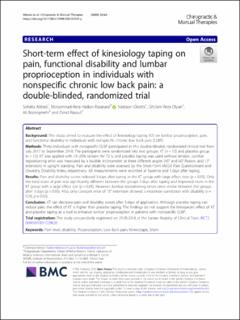| dc.contributor.author | Abbasi, Soheila | |
| dc.contributor.author | Hadian, Mohammad Reza | |
| dc.contributor.author | Ghotbi, Nastaran | |
| dc.contributor.author | Olyaei, Gholamreza | |
| dc.contributor.author | Rasouli, Omid | |
| dc.date.accessioned | 2021-01-25T09:22:39Z | |
| dc.date.available | 2021-01-25T09:22:39Z | |
| dc.date.created | 2020-11-11T09:44:27Z | |
| dc.date.issued | 2020 | |
| dc.identifier.issn | 2045-709X | |
| dc.identifier.uri | https://hdl.handle.net/11250/2724457 | |
| dc.description.abstract | Background: This study aimed to evaluate the effect of kinesiology taping (KT) on lumbar proprioception, pain, and functional disability in individuals with nonspecific chronic low back pain (CLBP). Methods: Thirty individuals with nonspecific CLBP participated in this double-blinded, randomized clinical trial from July 2017 to September 2018. The participants were randomized into two groups: KT (n=15) and placebo group (n=15). KT was applied with 15-25% tension for 72 hours, and placebo taping was used without tension. Lumbar repositioning error was measured by a bubble inclinometer at three different angles (45º and 60º flexion, and 15º extension) in upright standing. Pain and disability were assessed by the Short-Form McGill Pain Questionnaire and Oswestry Disability Index, respectively. All measurements were recorded at baseline and 3 days after taping. Results: Pain and disability scores reduced 3 days after taping in the KT group with large effect sizes (p <0.05). Only the total score of pain was significantly different between the groups 3 days after taping and improved more in the KT group with a large effect size (p< 0.05). However, lumbar repositioning errors were similar between the groups after 3 days (p> 0.05). Also, only constant error of 15º extension showed a moderate correlation with disability (r= 0.39, p= 0.02). Conclusion: KT can decrease pain and disability scores after 3 days of application. Although placebo taping can reduce pain, the effect of KT is higher than placebo taping. The findings do not support the therapeutic effect of KT and placebo taping as a tool to enhance lumbar proprioception in patients with nonspecific CLBP. Keywords: Pain level, Disability; Proprioception; Low Back Pain; Kinesiotape; Sham | en_US |
| dc.language.iso | eng | en_US |
| dc.publisher | BMC | en_US |
| dc.rights | Navngivelse 4.0 Internasjonal | * |
| dc.rights.uri | http://creativecommons.org/licenses/by/4.0/deed.no | * |
| dc.title | Short-term effect of kinesiology taping on pain, functional disability and lumbar proprioception in individuals with nonspecific chronic low back pain: a double-blinded, randomized trial | en_US |
| dc.type | Peer reviewed | en_US |
| dc.type | Journal article | en_US |
| dc.description.version | publishedVersion | en_US |
| dc.source.volume | 28 | en_US |
| dc.source.journal | Chiropractic and Manual Therapies | en_US |
| dc.source.issue | 63 | en_US |
| dc.identifier.doi | https://doi.org/10.1186/s12998-020-00349-y | |
| dc.identifier.cristin | 1846798 | |
| dc.description.localcode | © The Author(s). 2020 Open Access This article is licensed under a Creative Commons Attribution 4.0 International License, | en_US |
| cristin.ispublished | true | |
| cristin.fulltext | original | |
| cristin.qualitycode | 1 | |

